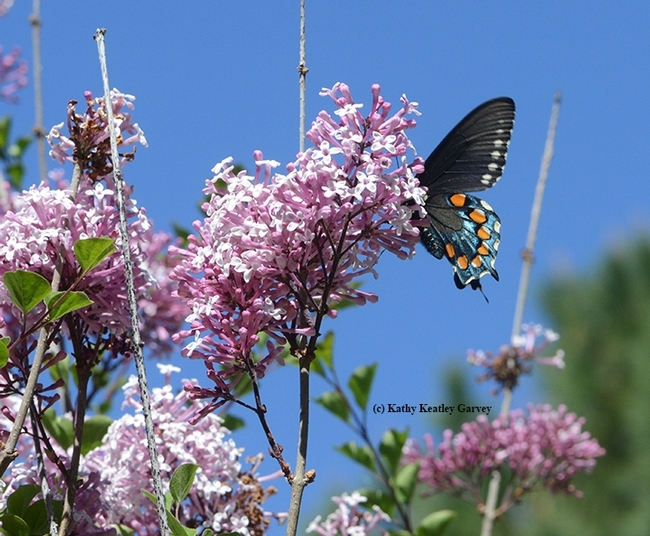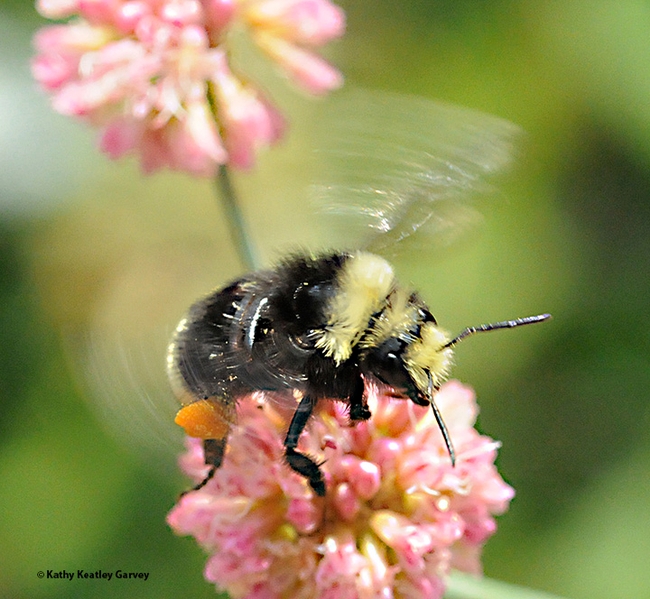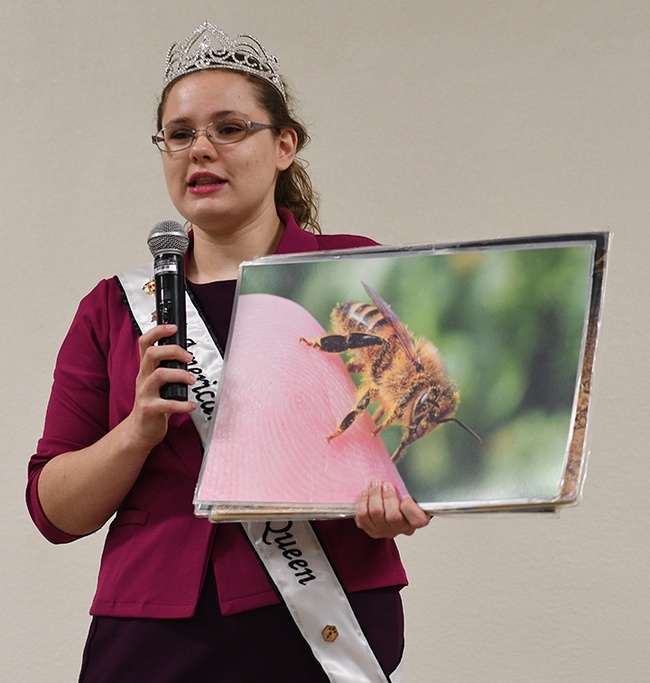- Author: Kathy Keatley Garvey
It was all the buzz.
Thousands of bee and honey enthusiasts made a beeline for the California Honey Festival, held last Saturday on the Yolo County Fairgrounds.
The annual festival, relocated this year from the streets of downtown Woodland to the fairgrounds due to a weather forecast cautioning heavy rain and wind, drew scores of smiles beneath the arched umbrellas.
Beekeeper Rick Moehrke, a retired Vacaville teacher, answered questions about bees in the Sacramento Area Beekeepers' Association booth.
American Honey Queen Kaelyn Sumner of Cecil, Wisc., a beekeeper and a senior at Kansas State University discussed queen bees, worker bees and drones. She is majoring in agricultural education and minoring in food science and entomology.
Charles McMaster, a U.S. Army veteran from Copperas Cove, Texas, headed the Hives for Heroes booth. The national non-profit service organization focuses on sustainability, conservation, and providing a healthy transition from service: "Through our national network of beekeepers, we provide connection, purpose, and healthy relationships, through access, resources, and funding for Active Duty, Veterans, and First Responders.">
Steve Hays, retired sheriff's deputy, Sacramento County and founder of Second Chance Beekeeping Reentry Service, chronicled the history of his program and how inmates are learning beekeeping and getting "a second chance." (See news story)
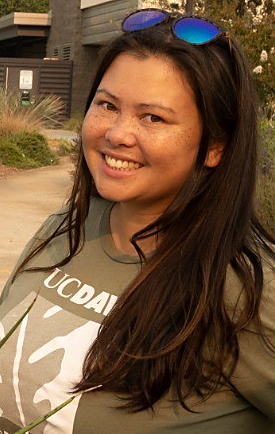
Amina Harris, retired founding director of the UC Davis Honey and Pollination Center and now the "Queen Bee" of her family's Woodland-based Z Food Specialty and The HIVE, offered guests "a taste of honey" from all over California. They also sold honey, including a family favorite, starthistle. Harris co-founded the California Honey Festival in 2017 with the City of Woodland.
Attendees tasted and purchased Hawaiian honey, with such varietals as Eucalyptus, macadamia, mango, Christmas bush, tropical blossom and wildflower, from "Queen Bee" Inna Eyrih, business owner of Hawaiian Honey AT&S, a company based in Hawaii (Keaau) and California.
GATEways horticulturist Rachel Davis of the UC Davis Arboretum and Public Garden discussed pollinator gardening, focusing on native bees, butterflies, moths, hoverflies, and hummingbirds.
This year's California Honey Festival lived up to its mission: to emphasize the importance of bees and to promote honey and bee products. The annual festival, co-sponsored by UC Davis, features educational presentations, kids' center activities, honey tasting, cooking demonstrations, a beer and mead garden, live music, vendors and more.
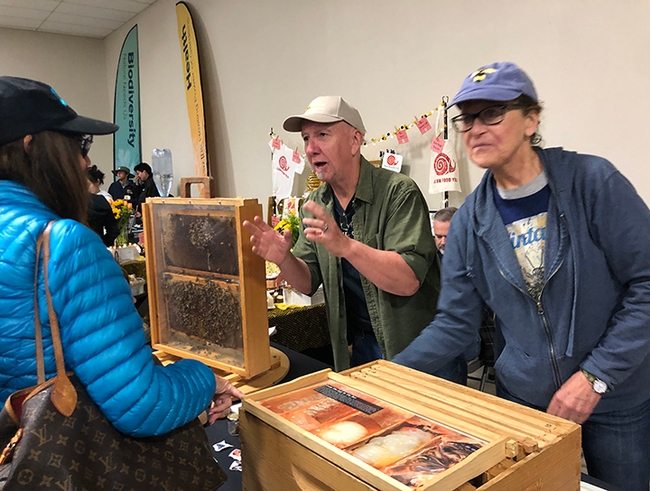
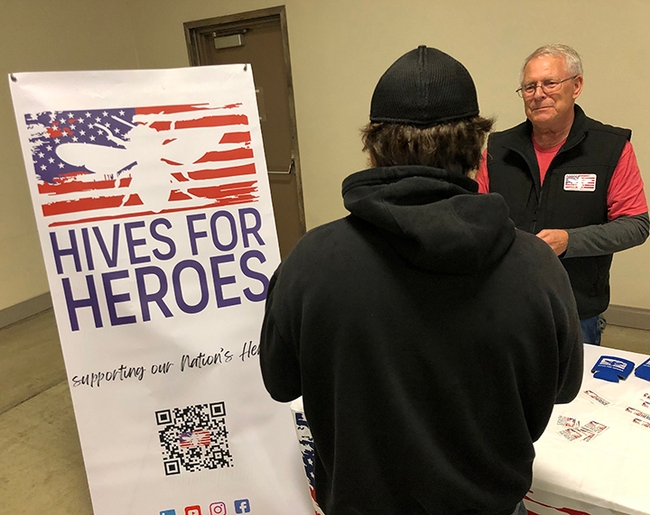
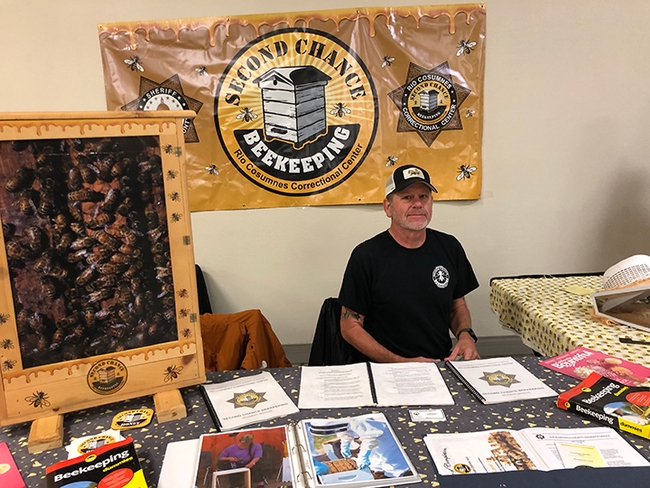
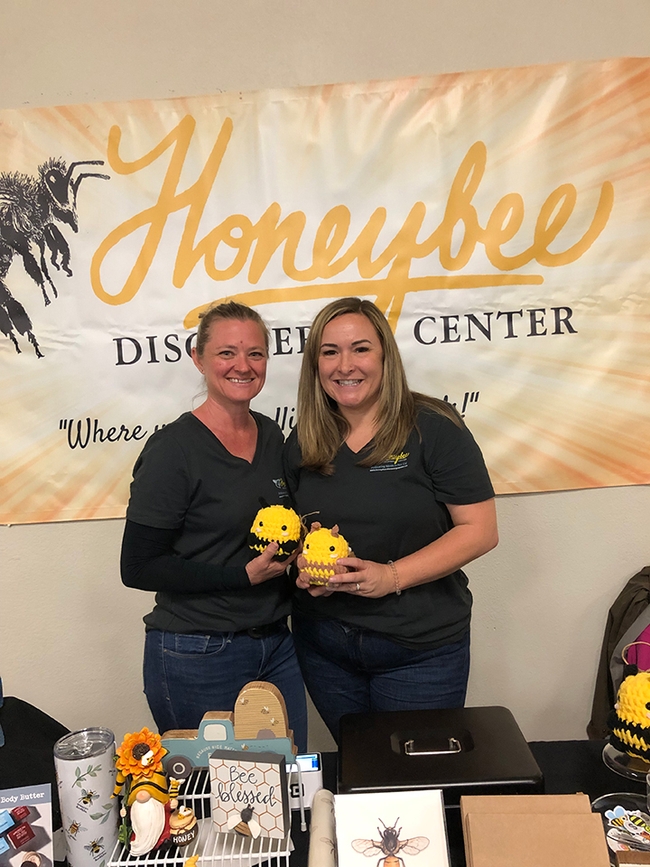
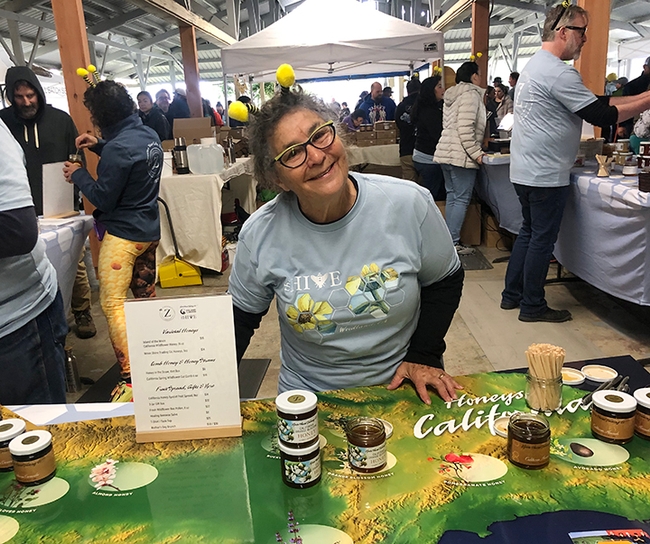

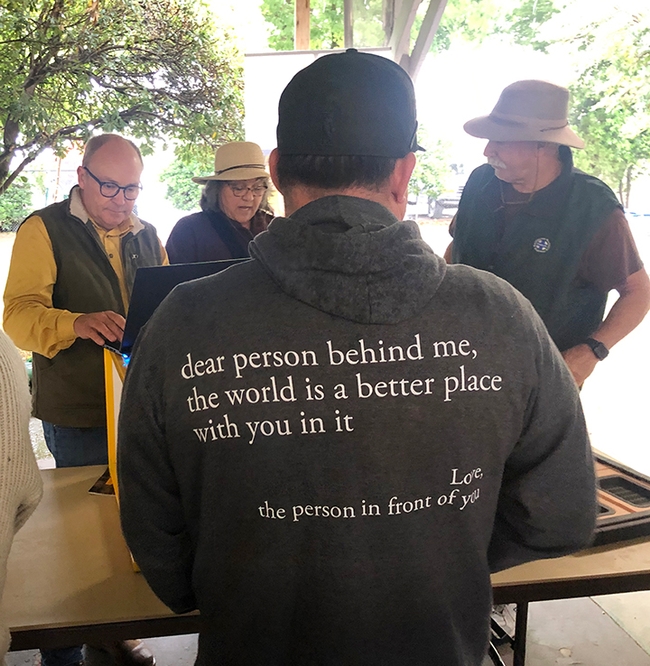
- Author: Kathy Keatley Garvey
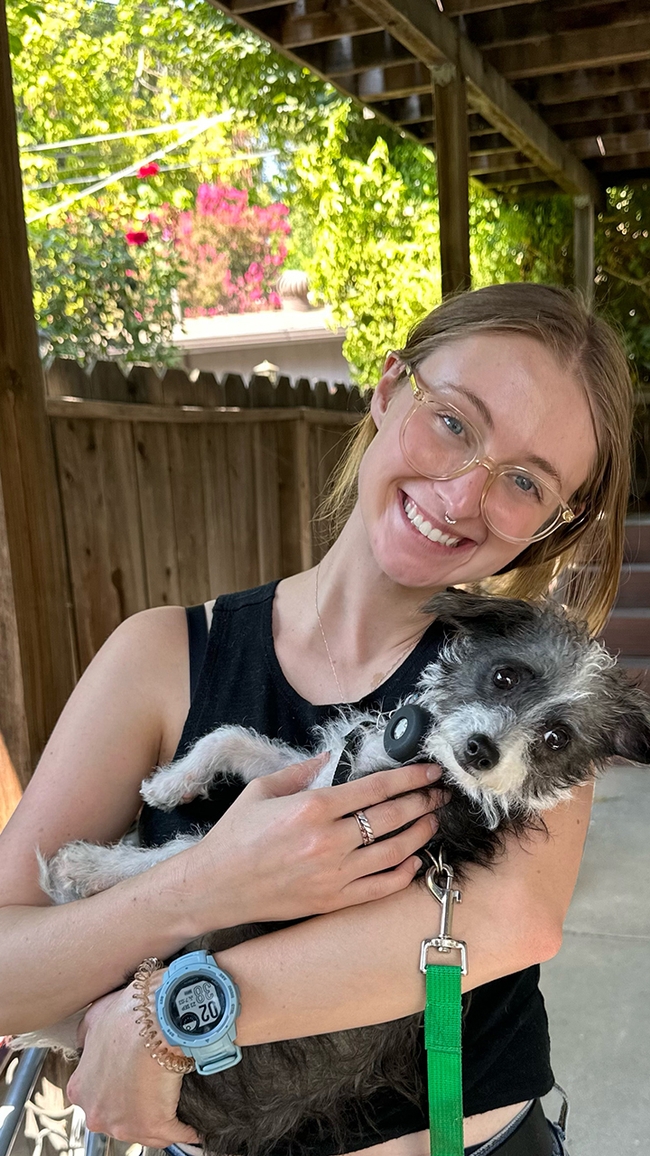
Doctoral student Grace Horne of the UC Davis Department of Entomology and Nematology is coordinating a City Nature Challenge Bioblitz on Saturday, April 27 from 8 to 10 p.m. in the UC Davis Arboretum and Public Garden. The family-friendly event, funded by the UC Davis Center for Citizen and Community Science, is open to all interested persons. "All ages are welcome," Horne said.
The nature challengers will meet at the Wyatt Deck, located at the west end of the Redwood Grove, across Arboretum Drive from the Wyatt Pavilion Theater. Registration is underway on this Eventbrite link:
https://iluvbugs2024.eventbrite.com.
"It's perfect for nature enthusiasts of all ages and experience levels,” Horne said, adding that it promises to be “an exciting opportunity to connect with nature and appreciate the beauty of bugs.”
Dubbed the #iluvbugs City Nature Challenge Arboretum BioBlitz and billed as "illuminating biodiversity search," the event will be an extension of Horne's first-ever "glowing bugs" exhibit (showcasing plant-insect interactions under ultraviolet light) at Briggs Hall during the 110th annual campuswide UC Davis Picnic Day on Saturday, April 20.
Bioblitz participants "will take photos of plants and animals--especially bugs!--and upload these observations to the community science platform, iNaturalist,” she said. “All you need to bring is a smartphone or a photo-taking device. We will have a table with small lenses, bug boxes, field guides, insect specimens, and more to help you make observations of wildlife. Local experts will also be available to assist in identifying the wildlife.”
The bioblitz is affiliated with the City Nature Challenge Sacramento. CNC is an annual worldwide competition among some 500 cities with the goal of documenting the most biodiversity within a four-day period. "Participants use the iNaturalist app and platform to photograph, catalog, identify, and organize observations of wildlife in their area," according to the CNC website. "From April 26-29, any iNaturalist photo uploaded within the Sacramento Region will count towards our goal of 10,000 observations."
"We are looking to make as many quality observations as we can during the UC Davis Bioblitz," said Horne, who is marking her second consecutive year hosting a bioblitz in the Arboretum.
Participants are asked to bring a flashlight, comfortable walking shoes, insect repellent, a camera/cell phone, binoculars (if desired), a water bottle, and weather-appropriate clothing.
Meineke Lab. Horne, who joined the UC Davis entomology graduate program in 2021 and studies with urban landscape entomologist and assistant professor Emily Meineke, is a 2021 graduate of Colby College, Waterville, ME, where she received her bachelor's degree in biology and environmental science, magna cum laude. Her thesis: "Reduced Performance of Ash-Specialist Caterpillars on Non-Native, Cultivated Oleaceous Plants.”
At UC Davis, Horne studies "plant-insect interactions using long-term data—primarily expert-collected observations and natural history collections. "Currently, I am investigating how moth populations in Davis and Stebbins Cold Canyon have changed over the past 30 or so years using data collected by John de Benedictis of the Bohart Museum of Entomology."
She is an alumna of The Caterpillar Lab in Marlborough, NH. "At The Caterpillar Lab, we brought together caterpillars and their host plants to teach about species interactions, conservation, and ecology," Horne said. "Our work brought us to museums, libraries, 4th grade classrooms, farmers' markets, etc."
Horne co-chairs the UC Davis Department of Entomology and Nematology's Picnic Day Committee with forensic entomologist Robert Kimsey. This year all of the department's exhibits and activities, including those hosted by the Bohart Museum of Entomology, will be at Briggs Hall.
Her Picnic Day exhibit, “I IUV Bugs," is her brainchild. The project is primarily designed by the Meineke lab, "especially (doctoral student) Marielle Hansel Friedman," Horne said. "We will have plants from the UC Davis Arboretum Teaching Nursery and local/pet-trade arthropods which glow under ultraviolet light. With this exhibit, we seek to highlight the interplay between light, color, and species interactions."
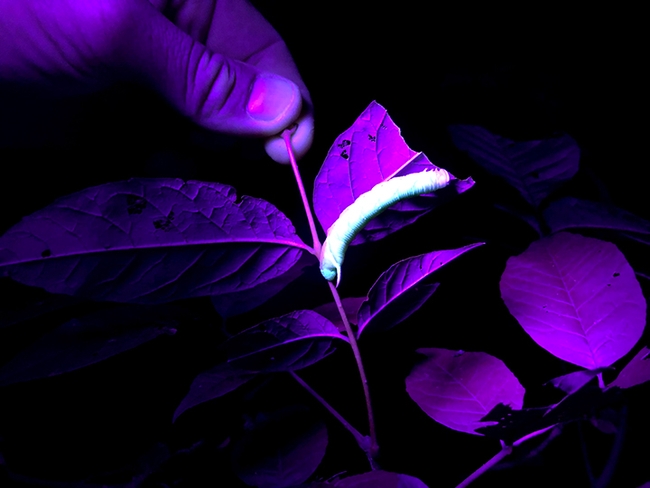
- Author: Kathy Keatley Garvey
One of the first butterflies we see in the UC Davis Arboretum and Public Garden in midwinter is the Red Admiral, Vanessa atalanta.
Yes, this butterfly overwinters as an adult. It's picture-perfect with black wings, red bands and white spots. And on a picture-perfect day in midwinter, you may see it.
Or as butterfly guru Art Shapiro, UC Davis distinguished professor emeritus, says on his Art's Butterfly World website: "One of the most frequently seen butterflies in midwinter at low elevation, and often very common in the urban Bay Area, the Red Admiral occurs all around the Northern Hemisphere. It is multiple-brooded, overwinters as an adult, and may undergo altitudinal migration in the Sierra (where it is generally uncommon)."
"The larval hosts are all members of the Nettle family, Urticaceae, including not only the familiar Stinging Nettles (Urtica holosericea and U. urens) but the tiny-leaved ground cover Baby's Tears (Helxine or Soleirolia) in moist, shaded gardens and the climbing urban weed Pellitory (Parietaria) in the Bay Area. The larva is solitary, in a rolled-leaf shelter."
Shapiro has been monitoring butterfly populations in Central California since 1972. And the Red Admiral is just one of them.
If you visit the UC Davis Arboretum a picture-perfect day, you must may get the opportunity to admire the Red Admiral...This one was on a Roldana aschenborniana (Golden Light Senecio).
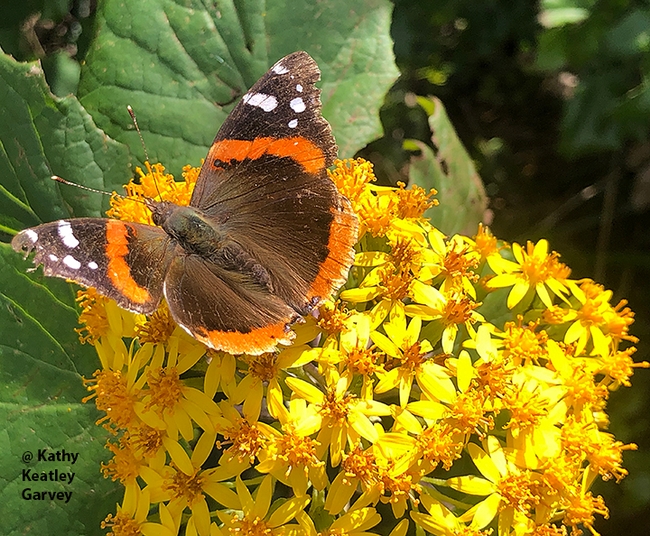
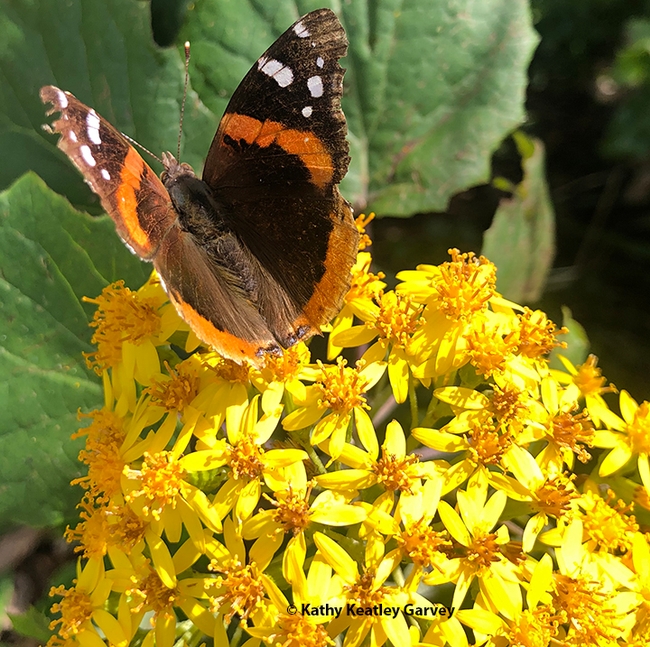
- Author: Kathy Keatley Garvey
If you've lately visited the Ruth Risdon Storer Garden, part of the 100-acre UC Davis Arboretum and Public Garden, you've seen them.
Honey bees nectaring on the Kniphofia "Christmas Cheer" poker plant.
Its stems, stretching 5 to 6 feet tall, are topped with brilliant spikes of reddish-orange tubular flowers. They are Santa Claus-red, honey yellow, and pumpkin orange, all wrapped in one.
The genus, Kniphofia, honors Johann Hieronymus Kniphof (1704 -1763), a German physician and botanist. Botanist Conrad Moench (1745–1805) bestowed the name.
Everywhere the plant goes, it spreads cheer.
Honey bees, buzzing out of their their hives when the temperature outside hits 55 degrees, spread their own kind of cheer, bringing back life-nourishing nectar to their sisters and queen bee in the dead of winter.
Cheers.
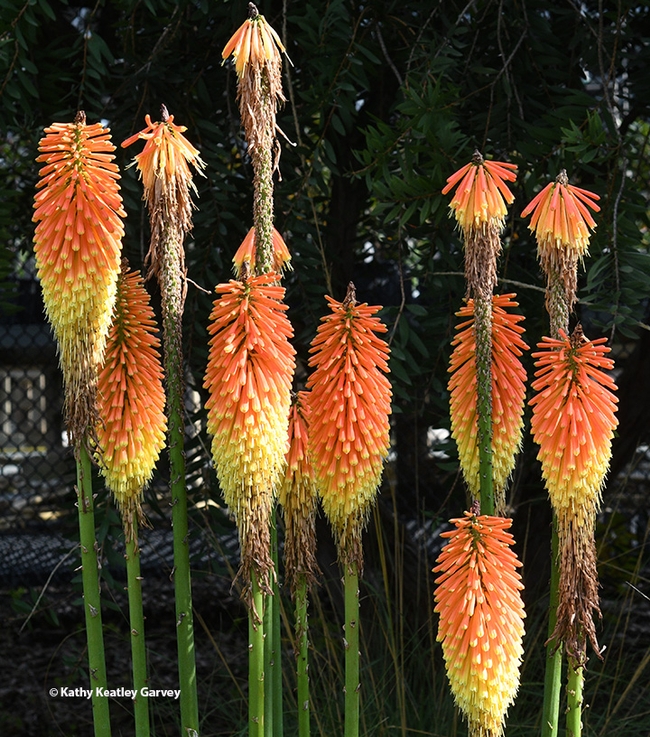
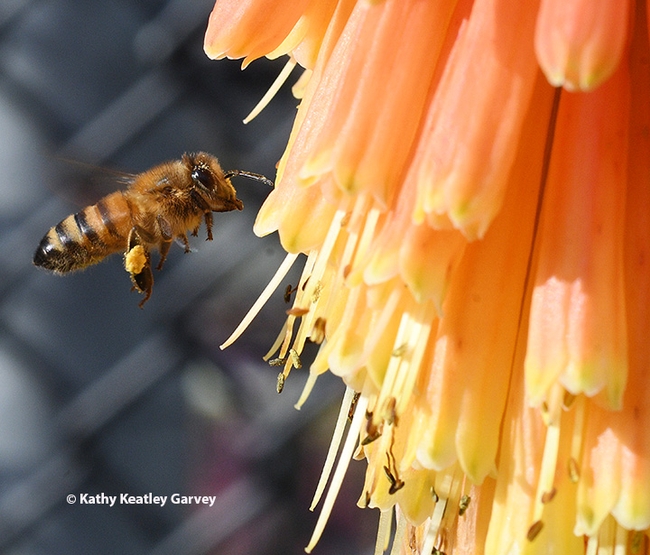
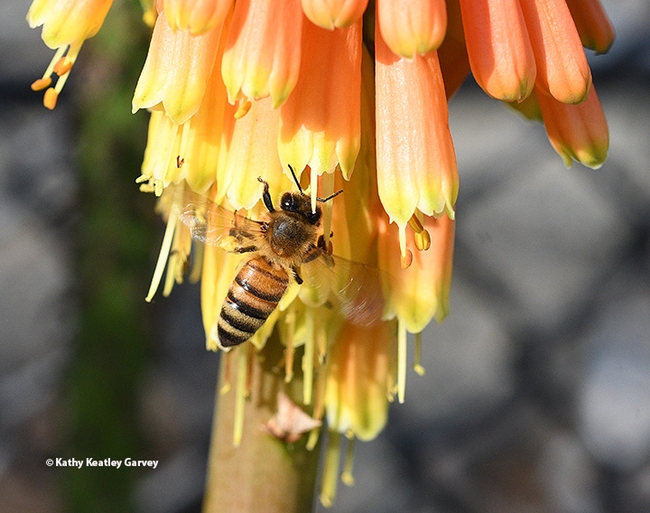
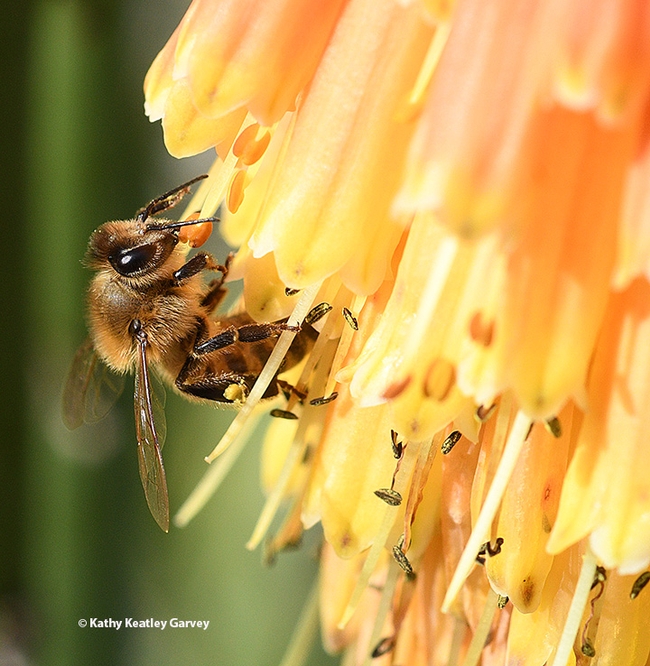
- Author: Kathy Keatley Garvey
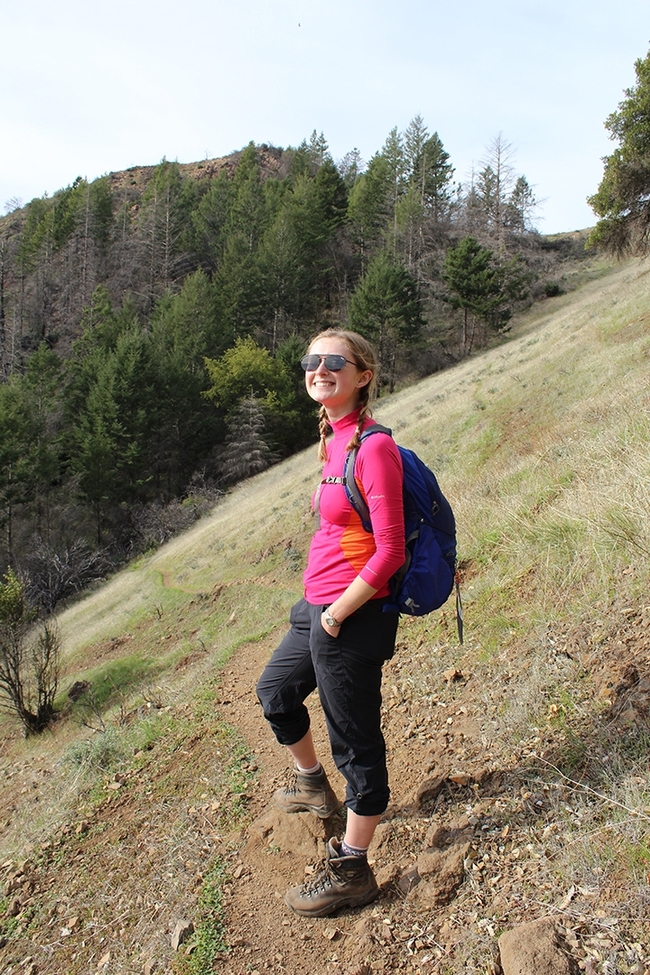
A BioBlitz is set from 9 to 11 a.m., Saturday, April 29 in the UC Davis Arboretum and Public Garden. It's being hosted by UC Davis doctoral student Grace Horne of the Department of Entomology and Nematology.
Participants will meet in at the Wyatt Deck (previously the BioBlitz was scheduled for the Carolee Shields White Flower Garden and Gazebo.)
"I am excited about the location change because we will be located next to two biodiversity hubs: The T. Elliot Weier Redwood Grove and the Mary Wattis Brown Garden of California Native Plants," said Horne, a member of the laboratory of urban landscape entomologist Emily Meineke, assistant professor, UC Davis Department of Entomology and Nematology.
Reservations (free) are underway here.
“We need your help to track and identify the wildlife in Davis!" said Horne, a member of the laboratory of urban landscape entomologist Emily Meineke, assistant professor, UC Davis Department of Entomology and Nematology. "Participants will take photos of plants, animals, and fungi, and upload these observations to the community science platform, iNaturalist. All you need to bring is a smartphone or a photo-taking device. We will have a table with small lenses, bug boxes, field guides, insect specimens, and more to help you make observations of wildlife. Local experts will also be available to assist in identifying the wildlife."
This event will be hosted in coordination with the City Nature Challenge Sacramento. The City Nature Challenge (CNC) is an annual international competition among cities with the goal of documenting the most biodiversity within a four-day period.
This year the challenge will occur from April 28 to May 1, "so any observations of wildlife that are uploaded to iNaturalist will contribute to the 2023 CNC," Horne said. "At the end of the CNC, the region with the most observations wins. We are looking to make as many quality observations as we can during the Davis Bioblitz, so stop by the Shields Gazebo to help contribute observations to the Greater Sacramento Region!”
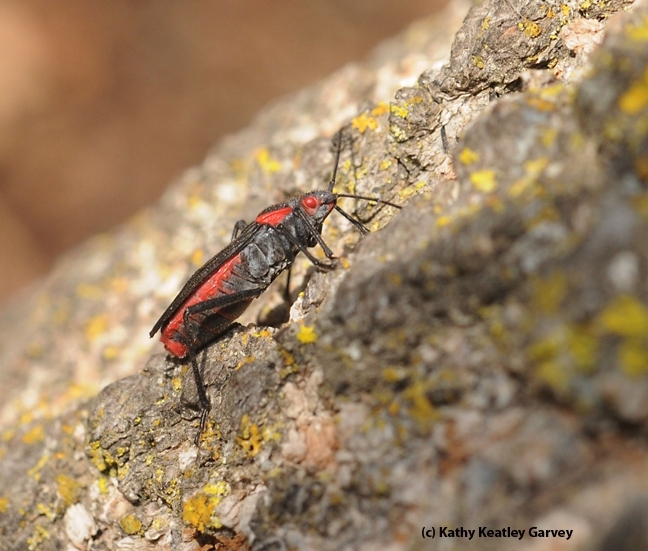
Horne's undergraduate thesis about the effects of the decline of ash trees on native caterpillars, scored the cover of the February edition of the journal Environmental Entomology. The paper, “Specialist Herbivore Performance on Introduced Plants During Native Host Decline,” is co-authored by Ria Manderino of the Oak Spring Garden Foundation, Upperville, VA and Samuel Jaffe of The Caterpillar Lab, Marlborough, N.H. “Our publication highlights the importance of multispecies assessments of host plant acceptance,” said Horne, who studies plant-insect interactions, urban ecology, global change biology, natural history and community science in the Meineke lab.

